Pesky Bugs And Insects
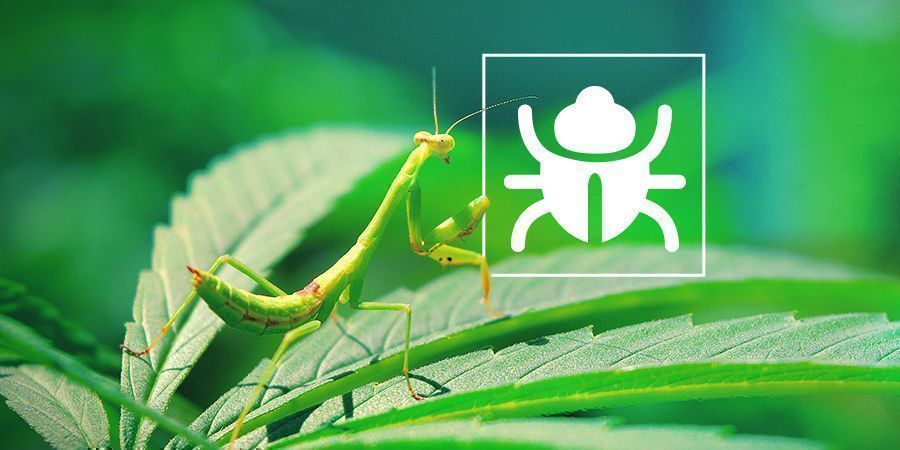
The cannabis cultivator is locked in a cold war with all kinds of creepy crawlies. Like it or not, it is the grower’s duty to ensure this war never turns hot. However, despite one’s best efforts and use of preventative measures, a grow-op can still be invaded by bugs and insects. There are more than a few potential nasty little threats to be on the lookout for.
Armed with the knowledge contained in this guide, you will be prepared to defend your cannabis plants. Whether it’s a swarm of fungus gnats, thrips, or whiteflies, we’ve got countermeasures and simple, practical advice to help. Welcome to the weed war. If you are reading this, you are the resistance.
Caterpillars
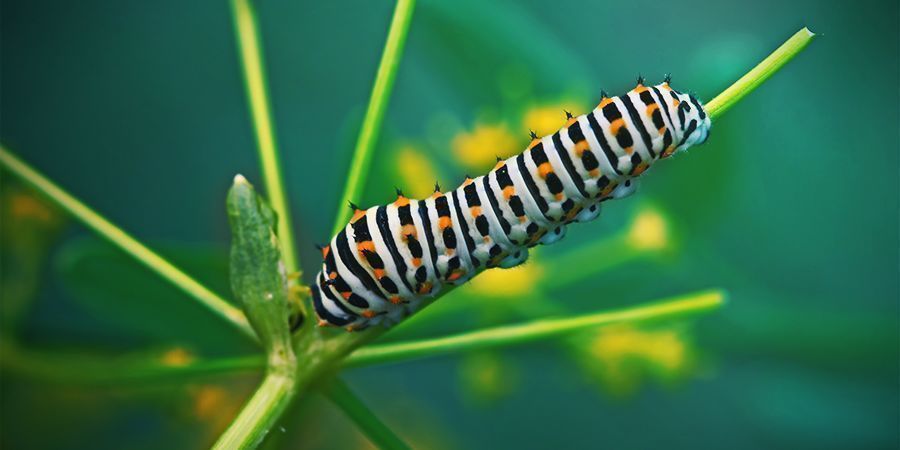
A caterpillar is the larva of a butterfly. Caterpillars are generally inconspicuous creatures, yet some species play a large role in human affairs and are very well known, examples being the silkworm (the caterpillar of the silk moth) and the oak processionary moth (Thaumethopea processionea, a pest that attacks oak trees).
Caterpillars are also an important element in ecosystems; not only do they remove a huge volume of plant material, they are also prey for a wide diversity of animals, from birds to parasite wasps.
Caterpillars are quick growers that get through a huge amount of food. They have a characteristic body construction that bears little resemblance to the larvae of any other of the insect orders. Caterpillars have many ingenious techniques for evading the clutches of predators, and some of these can be a hassle for humans too (and for our beloved plants).
Damage report
Curled leaves, or leaves with nibbled holes. Feeding damage by caterpillars mostly occurs in late summer and autumn, but in recent years, caterpillar infestations have been, strikingly so, more and more in the beginning of the growing season.
Combating
There is a range of methods and products for dealing effectively with caterpillars. Caterpillars tend to curl themselves up in the leaf. With a single caterpillar, this can easily be dealt with by removing it by hand. But if you have a real infestation then you can use the Bacillus thuringiensis bacteria to attack the caterpillars with. This bacterium interferes with the absorption of food by the caterpillar thanks to which is stops feeding itself and dies.
A product like Decis (not to be confused with Confidor) could help. How to use: mix 10ml with 15 litres of water. Spray when the temperature is above 15° Celsius and when no rain is expected for the next six hours, and by preference when there’s no wind. Completely soak the plants from above to below. Do an inspection after 10 days. If there are still living caterpillars, repeat the treatment.
Cicadas (Empoasca decipiens)
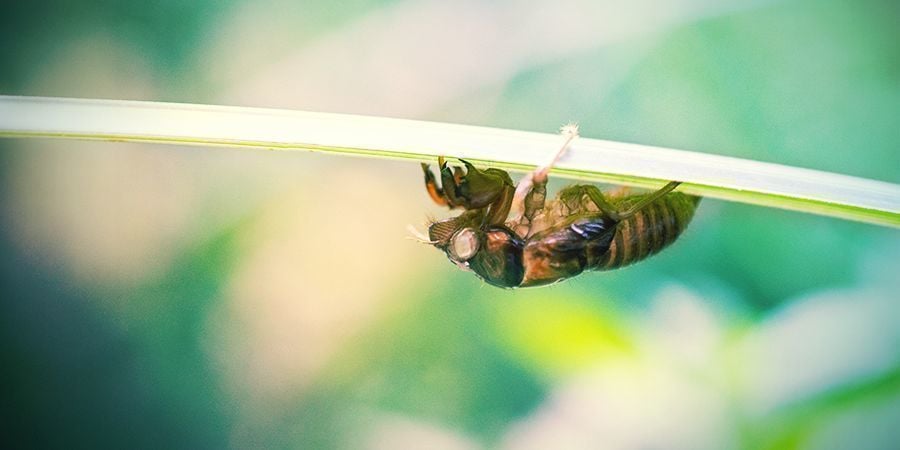
Damage and identification
In the summertime is when you can encounter trouble with cicadas (Empoasca decipiens). Cicadas are recognizable by their light green colour. In some situations they can cause damage to the leaves or buds of your plants, sucking sap from the plants’ mesophyll (the soft tissue beneath the surface of the plant responsible for photosynthesis).
By doing this they cause rows of speckles on the leaves, flowers and fruits. This reduces the value of the products. In cases of serious infestation, large parts of the leaf discolour and even die off. This speeds up the ageing of the plant. Some cicadas carry viruses and mycoplasma bacteria or secrete toxins that can result in plant deformities.
Lifecycle
In glasshouse horticulture, a single generation will come to maturity in four to five weeks depending on the temperature. Cicadas go through an egg stage, five nymph stages and the adult stage in their life cycle. The adult insects are 2 to 3 mm long and in many species coloured green. A female cicada can lay up to 50 eggs during her life. These are white, kidney-shaped and approximately 0.6 mm long. They are laid in the tissue of leaf veins and stems, where they are not visible to the naked eye.
At 15 degrees C. and with an air moisture content between 65-75% it takes about 28 days for the eggs to hatch. At 20 degrees C. that is reduced to 15 days and at 24 degrees C. just 11 days. The nymphs are lighter in colour, and with each succeeding nymph stage the wing construction becomes clearer and clearer to see.
The highly agile nymph has an interesting method of scuttling: diagonally. The nymph stage of Empoasca decipiens lasts 37, 19 or 15 days respectively at 15, 20 and 24 degrees Celsius.
Combating cicadas
Combating cicadas can only be done by chemical means at the moment. With financing from the Dutch Horticultural Commodity Board (Productschap Tuinbouw) the agricultural university at Wageningen began research in 2005 into the impact of cicadas on flower growing under glass. They found that Empoasca decipiens was the most common cicada found in this environment.
In enclosed lab conditions, the researchers looked at cicada predation by generalist predators. In the field, both the nymphs and the adults are very mobile and hard to catch. In a field test, it appeared that the parasitic wasp Anagrus atomus was able to reproduce under glasshouse conditions.
However, no significant parasite infestation percentage was achieved, and the possibilities for using these wasps as an effective biological pesticide look slim.
The neonicotinoids imidacloprid (Admire), thiacloprid (Calypso), thiamethoxam (Actara) and acetamiprid (Gazelle) are very effective against cicadas, as is the oxidiazine indoxacarb (Steward). This anti-caterpillar agent is a more selective therefore safer option against natural pests than the neonicotinoids.
Cockchafer
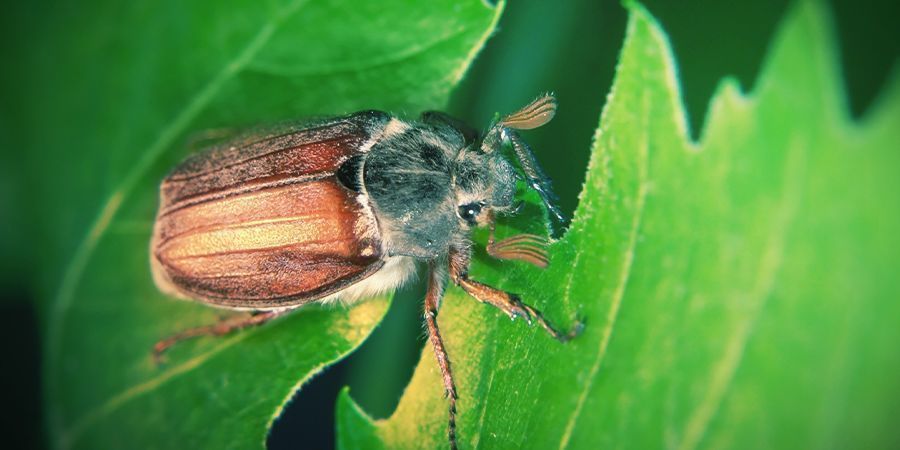
In Western Europe, we have around 3,800 species of beetle. A number of these are particularly bothersome, such as the cockchafer (also known as the May bug, the Spang beetle or the Billy witch). This parasite in the genus Melolontha is matt black in colour with light (yellow) flecks. Cockchafers are about 1cm long and have feelers on their protruding snout. On its shell are longitudinal grooves.
The beetles are generally active at night and eat angular bites out of the edges of leaves. The cockchafer crawls and climbs very well: many metres a night. The larva is about 10-14 mm long in its final stage, dirty white to cream-coloured with a red-brown head. The body is often slightly curved (C-shaped).
Features
- Mostly active at night,
- If they feel they’ve been spotted they stand stock still
- Start eating from the edge of the leaf inwards
- Larvae are found up to 10 cm deep in soil and feed on roots
Combating
Dealing with beetles is a real pain. A chemical pesticide often affects not just the beetle but also other, useful, insects. A biological solution to the larvae is possible with parasitic nematode worms. Other natural enemies of the cockchafer beetle include: various beetles, frogs/toads, and bantams. The most important enemies of the larvae include various moulds, nematodes, bacteria and again, chickens.
Fungus Gnats
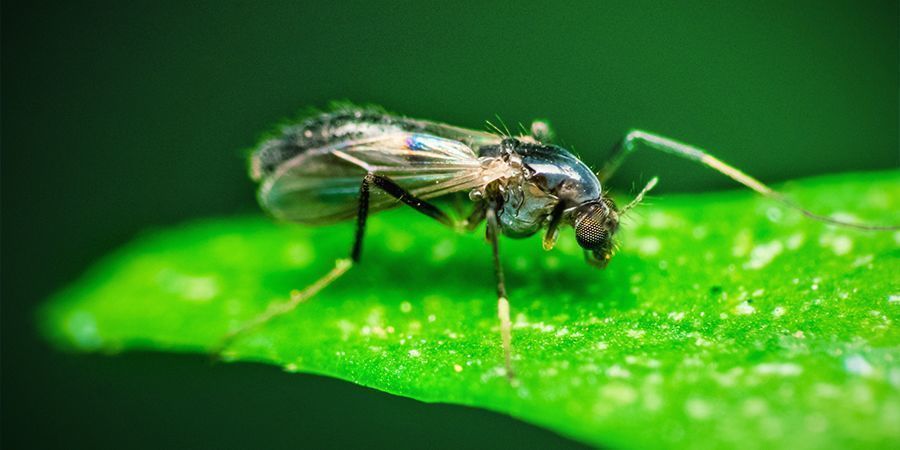
Fungus gnats are members of the Sciaridae family. They’re small (3-5 mm), dark, mosquito-like flies with long, slender antennae and long legs. It is particularly the Fungus gnat larvae that do the most damage.
Biology
Fungus gnats are especially fond of warm, moist environments in the proximity of plants. They can also survive the whole year round in greenhouses.
After mating the females lay 50-200 eggs that hatch within 2-3 days. The larvae over the course of a 2-3 week period go through four stages, at the end of which they are around 5 mm long, transparent white and have a noticeable black head.
The larvae pupate in the soil and appear three days later as adult gnats. With temperatures higher than 24° C, they reproduce continuously and with a 3-4 week life cycle, rapidly. The larvae feed not only on dead organic material such as moulds and algae but also on living material like root- and stem tissue. They bore into the root and/or stem of cuttings, seedlings and young plants. Thanks to the feeding damage, a number of routes to secondary infection are opened up, giving plant diseases such as Pithium, Phytophtora, Botrytis, Fusarium and Verticillium an opportunity.
Recognition
- Size: 2-3 mm
- Eyes are unclear
- Non-branching antennae
- Elongated body divided into: head, broad thorax, narrow ribbed abdomen
- Brown-black body colour
NB: Observe also the characteristic patterning in the wings
Damage
The larvae can cause direct damage by nibbling on roots and stems – they can even bore right the way through them. Indirect damage is also caused thanks to the larvae spreading nematodes, mites, mould spores and viruses.
Combating
- Clear away dead organic material and use good quality compost.
- Hypoaspis miles: The soil-dwelling predatory mite Hypoaspis miles is a specialist in hoovering up Fungus gnat larvae.
- Atheta coriaria: The predatory beetle Atheta coriaria is an extremely voracious and efficient predator of Fungus.
- Steinernema-System: The Steinernema-System (using nematodes) can be used successfully against Fungus gnat
- Nematoda: Roundworms or nematodes invade the eggs and larvae of Fungus gnats to reproduce themselves.
Leafminer
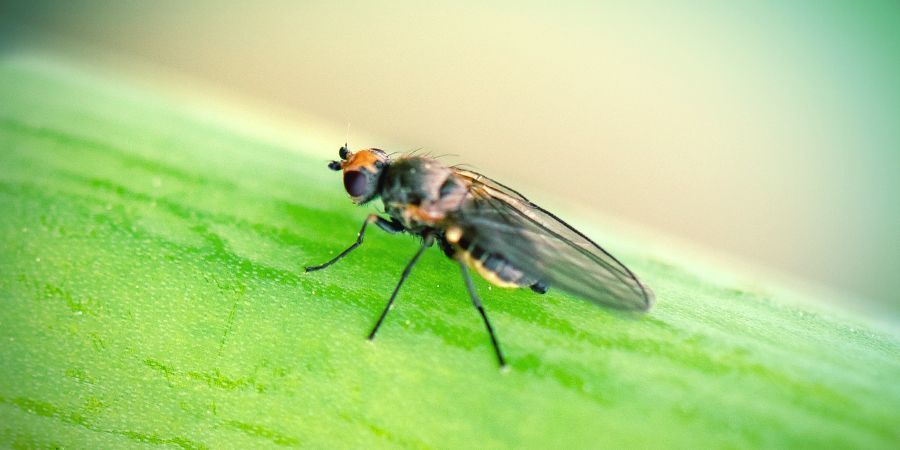
There are three varieties of leafminer that that are generally capable of becoming a pest: the tomato leafminer (Liriomyza bryoniae), the florida leafminer (Liriomyza trifolii) and the grain leafminer (Liriomyza huidobrensis). Under natural conditions their larvae are kept under control by heavy parasitism from various species. But problems with leafminers have increased by the widespread use of broad-spectrum pesticides: their natural enemies are killed and the leafminers develop resistance against the scattergun use of these sprays.
Life cycle
Leafminers have the following observable development stages: the egg stage, three larval stages, a pupae stage and an adult stage. The adult leafminers are small, yellow with black markings flies. The larval miners burrow into the plant’s leaves. The pupation takes place underground.
Signs of damage
Larvae literally ‘dig mines’ into the plant, which leads to the leaves drying out and falling off prematurely, as well as cosmetic damage. Losing leaves like this can also affect the plant’s yield. Feeding pinpricks made by female adults can lead to cosmetic damage too. Mould or bacteria can get into these dot-like wounds and go on to cause indirect damage.
Snails & slugs - general
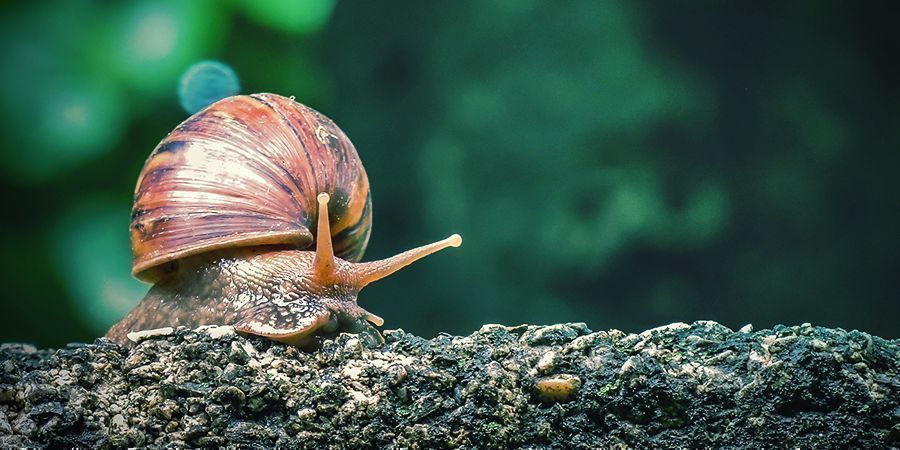
There are two basic varieties of slimy nibbling creatures: the naked slug and the snail with its shell. These two categories can be further sub-divided, but to do so serves little use for what we’re interested in. For the purpose of this article we’ll refer to “slugs” to mean both varieties unless one species is meant in particular.
Slugs are useful creatures: they clean up fallen leaves and process them for re-cycling, making them an essential part of the process of soil humus formation. Sadly for the cannabis grower, slugs are also the biggest enemy of the cannabis plant. Although both slugs and snails will enjoy decimating your plants, it is the naked slug that causes the biggest damage. Just to be on the safe side you can remove snails by hand.
Both move by making undulating muscular contractions band use a special sort of slime for moving vertically. By using this they can remain stuck and countering the effects of gravity for a long time.
Slug reproduction
Slugs reproduce themselves, of more accurately by themselves. After fertilization, snails lay their eggs in a hole in the ground, under a stone, in a crack in the soil or a piece of wood, or in a compost heap.That’s why it is certainly good advice not to plant your weed too near a compost heap.
The eggs hatch after the winter, if they survive the frost, and will soon start looking for food. So make sure that your plants aren’t the first tasty snack they see.
Diagnosing slug damage
The most prominent of slug attack is the presence of slime trails. Furthermore, you’ll see that whole sections of your leaf cover has been eaten, right down to just above the ground. Non-eaten leaves are sometimes used as a ‘getaway’ route for the little buggers.
Preventing and dealing with slug attacks
There are a number of different substances for use against slug attack.
- Coffee grounds: sprinkle around your plants: this muddies up their slime trail, thanks to which the slugs are reluctant to crawl over it
- Charcoal: sprinkle around your plants: also interferes with the slime trail, and also messes with the moisture balance of the slug, thanks to which they can die on the charcoal
- Slug pellets: scatter around (choose the organic ones!)
- Beer burial: bury a beer glass in the ground with the lip protruding, with some beer inside. Change the beer each day.
- Make a barrier out of copper: demarcate your garden with it, stick copper tape on your pots, making a copper circle around your plant pot.
- Sprinkle salt on slugs: not very animal-friendly, they gradually die from dehydration!
Suffered from slug attack?
You don’t need to do anything. Just allow your plant to repair itself. You can apply the methods above, manually remove snails or, if the damage is too severe, try to take a cutting from your plant and clone it.
Spider Mites
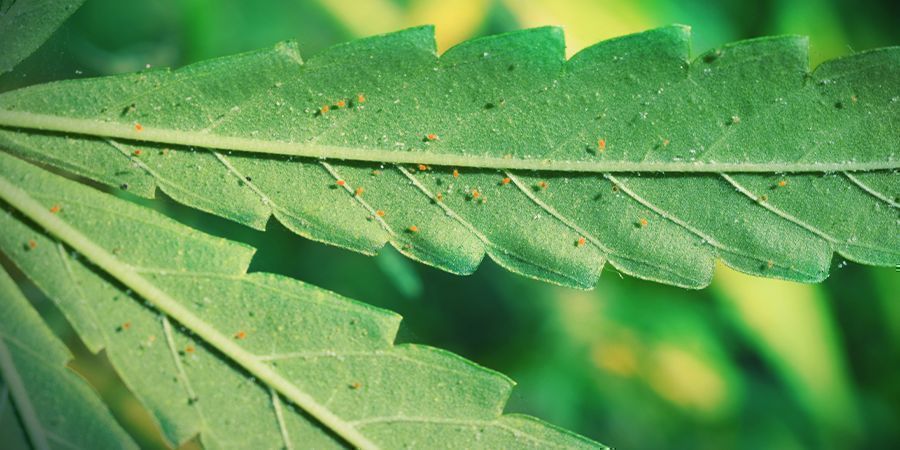
Spint (red spider mite): an annoying and almost invisible pest.
Certainly, among garden lovers, the 'spint plague' is an ever-recurring annoyance. Prevention is an effective weapon against what in Dutch is called spint, a handier name than the English red spider mite (so we’ll use them interchangeably here). Anyway, check regularly to prevent this minuscule pest from getting a foothold on your plants.
Recognising spint
Spint mites are plant parasites that are usually between 0.2 and 0.5 mm in size. There are many species of mite, and unlike insects, they have eight legs, which are pointed conspicuously to the front and back. They have a pear-shaped, yellowy-green, brownish or red body. Spint mites thrive in warm, dry conditions and particularly pick on plants that are under stress and weakened from drying out. They pierce the cell walls of buds, flowers and fruit and suck them dry. Thanks to this the cells are no longer able to take up sufficient nutrients, with inevitable results.
Symptoms of spint
Spint mites multiply rapidly in warm, dry weather. In a single year, up to nine generations are possible and each female can lay 80 or so eggs. The parasites survive the winter as eggs, as adults hidden in the soil or in the crevices in bark. Usually, you’ll be able to observe the symptoms before the actual infestation itself. The first signs are tiny: silverish or yellow speckles on the upper side of the leaves. With a serious infestation, their webs can cover an entire plant.
Spint prevention
Prevention is the best cure. So for a start keep your plants and their environment a little moist. If you discover an infestation, remove the infested parts as quickly as possible. Then rinse the plant thoroughly with a solution of methylated spirits and soapsuds. Repeat this treatment a few times a week.
If you still have the infestation after a few weeks, then your best option is to apply a substance based on natural pyrethrum. However, be careful with these agents because they’re also harmful to humans if you ingest them or let them come into contact with an open wound. Here we must also bear in mind that thanks to the rapid succession of generations, these spint mites can quickly develop resistance. That’s to say that after a number of applications of a particular substance and failing to eradicate them, only using a different one is likely to help. What’s more, most insecticides have no effect on the eggs.
We can also choose to use a biological enemy against them, such as various predatory mites and bugs, ladybirds, and lacewings.
Thrips
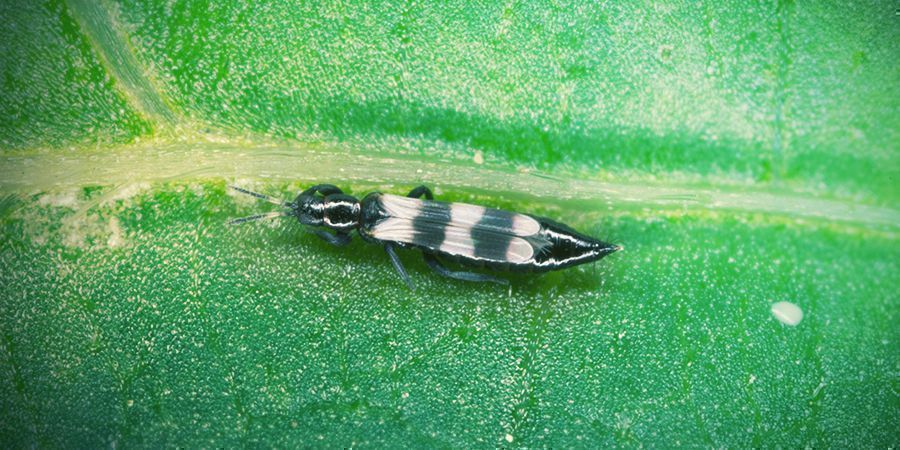
Thrips (Thysanoptera) are small, slender insects with ravelled wings, from which comes the scientific name Thysanoptera: a combination of the Greek thysanos (ravel) and pteron (wing). Other common names for thrips are storm flies and storm bugs. Thrips feed on sap from the cells of various plants (and on some animals) by pricking holes in the cell and sucking out the contents. Thanks to this, many species of thrips are regarded by farmers as pests because they damage plants. Other species of thrips feed on the fluids of other insects or mites and are regarded as farmers’ friends, while the rest of the species in the family feed on the fluids of moulds. So far we know of around 5000 different species.
Recognizing Thrips
Thrips are very small (<1 mm in diameter) and cannot fly very well, although by using thermals and wind they can be found in large numbers at very high locations. Under optimal conditions thrips can reproduce and multiply very quickly to the point that they’re seen as more than just annoying but an infestation to be dealt with.
This creature has mouthparts that stab and suck which it uses to pierce and suck dry cells, thanks to which the cell dies. Unlike lice they do not release any poisonous fluids into the cell but they do introduce air. After a short while the plant will begin to take on a gray, dried out appearance because its cells are being sucked dry. These insects can move location easily and as a result are capable of causing considerable damage in a short space of time.
The thrips lays its eggs in leaf tissue, and they hatch after 8 days. The young larvae are whitish in colour and live together in groups. At a later stage of the lifecycle they spread out over the whole leaf. After 14 days they begin their pupation.
The most common species of thrips are the Striped Greenhouse thrips (Parthenothrips dracanae) and the Tobacco thrips (Thrips tabaci). The Californian thrips is especially difficult to combat thanks to its good resistance to various insecticides.
Californian thrips are mostly found in greenhouses, but during the summer they can also cause problems outside. It is unclear whether they can survive European winters outside though. The Californian thrips generally pupates underground or in sheltered places, but sometimes also on leaves and in flowers. The lifecycle lasts 2 to 3 weeks when temperatures are between 20-30°C. Californian thrips is a carrier of TSWV (Tomato Spotted Wilt Virus) affecting various plants, including chrysanthemums and amaryllis.
Characteristics of Californian Thrips
- about 1.3-1.4 mm in size
- adult thrips are yellow to orange in colour
- adult thrips are mostly found in the uppermost sections of the plant
- their antennae have eight segments (you can check with a magnifying lens)
- flower heads and growth shoots can grow seriously deformed
- if there are buds or flowers present, the thrips can also transport pollen to them
- pupation generally takes place underground
- does not enter diapause (hibernation in adverse conditions)
- can bring viral infections with them
Combating Thrips
For a start it is most important that you raise moisture levels up to around 75-80% because then at least the infestation will spread more slowly; thrips does not like high moisture levels. This on its own will not be enough to rid yourself of the critters. But washing the plants with a solution of gentle liquid soap (20 g per litre) and 10cc of methylated spirit Is a simple remedy. If this doesn’t give the desired result the following techniques might help:
If you want to try a biological method you can work with a predatory bug. You can buy these from specialist companies. They feed on insects including thrips and mites, and these are the most effective:
- Amblyseius cucumeris: a light brown, very mobile hunting mite that prefers to work in high air moisture and a temperature around 25 degrees. The cycle of egg to adult takes (depending on the temperature) 8-11 days. This predatory mite lives for 18-21 days and takes the thrips while they’re in their larval stage and sucks them dry. This is also why it’s worth releasing some of these predators as a preventative measure in every infestation and/or with each new planting – in fact, it’s a recommendation that you do.
- Amblyseius degenerans: a predatory mite that’s a bit bigger than its 'sister' Cucumeris. The lifecycle is comparable with that of the Cucumeris. Degenerans is more mobile, less sensitive to temperature and thrives better in lower humidity. Degenerans is more common than Cucumeris in the buds and catches thrips in the same way as Cucumeris. The higher mobility, lower sensitivity to temperature and air moisture content and ability to hide itself in the flower/bud makes Degenerans somewhat more successful / effective than Cucumeris, especially in low humidity conditions. The drawback is that Degenerans is harder to raise and therefore more expensive and not always available.
- Orius laevigatus: a fast, dark-brown predator bug, 1-3mm in size with characteristic red eyes. The cycle from egg to adult takes about 2-3 weeks; the adult bug lives for three to four weeks. The speed of this cycle as well as their lifespan are dependent on the temperature. In association with Degenerans or Cucumeris, Orius is capable of keeping the thrips population down to acceptable levels, or even eradicate them completely. It’s highly recommended that you release Orius at the first sign of thrips. When there are no more thrips left to hunt, Orius will also eat other insects in the grow room, such as red spider mite, aphid and white fly. What’s more, Orius is the only natural enemy that besides attacking the larvae also preys on the adult thrips. Orius sucks the prey dry and is a ravenous and aggressive hunter that has even been known to hunt prey without bothering to eat them afterwards.
- Chrysopa carnea: a lacewing, the lava of which is a very aggressive ‘suck ‘til dry’-style hunter. These larvae are very active for 12-13 days and in this timeframe can make significant inroads in to infestations of the pests they prey on (whitefly, thrips and aphid). Although Carnea is less active against thrips and is mostly used for controlling aphid populations, the larvae of this lacewing species are frequently applied too, as Carnea can deal outstandingly well with fluctuations in temperature and air moisture. Preventative release of this lacewing does not make sense though. Only release them when pests are visible, as the larvae are very mobile and will wander off if not released close to a population of prey.
Whitefly
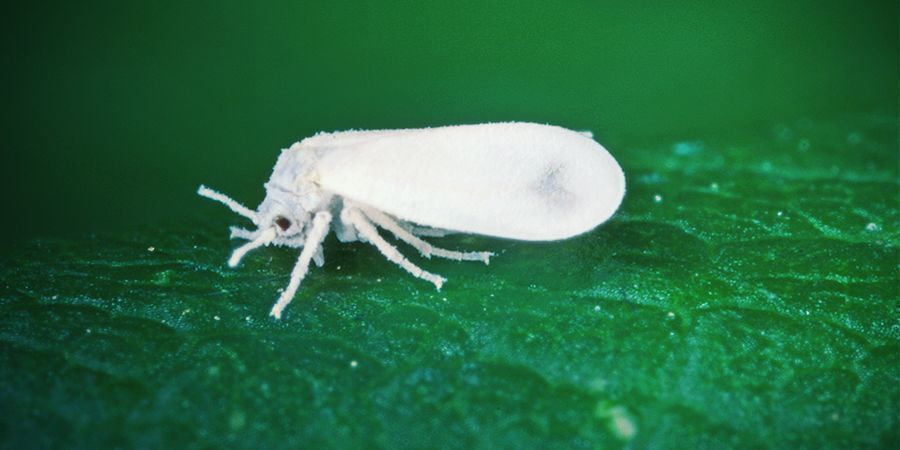
Whitefly is the name given to a variety of bug-like insects that belong to the Aleyrodidae family. They are small members of the Hemiptera (‘true bugs’) order that feed on the underside of the leaves of plants. They damage host plants by boring into the phloem (the tissue that transports sugars around the plant). The plant loses turgor as a result, and it also reacts to the toxic saliva of white flies.
Because white flies live together in large groups they can quickly decimate a plant totally. Their impact can be so serious that when someone brushes against a leaf a swarm of white flies takes off, flutters about before re-landing on the underside of the leaf again. They also excrete honeydew, which can become a food source for moulds, while the stickiness of the stuff can also become a terminal problem for some plants, such as cotton.
One of the best-known species is the Greenhouse whitefly (Trialeurodes vaporariorum) which is an insect pest in greenhouse horticulture. Other well known species include the silverleaf or sweet potato whitefly (Bemisia argentifolii) and the Banded winged whitefly (Trialeurodes abutiloneus).
Combating
Combating whitefly is difficult. The Greenhouse whitefly has developed resistance to many pesticides. The United States Department of Agriculture recommends prevention of infestation by using a biological agent when possible. They advise the application of yellow, sticky traps to detect the presence of whitefly and only applying insecticide selectively.
The whitefly can also be combated with the help of its natural enemies such as the ichneumon family of parasitic wasps. The predator bug hunts whitefly for food, and the larvae of lacewings also attack whitefly and suck them empty.
CUTWORMS
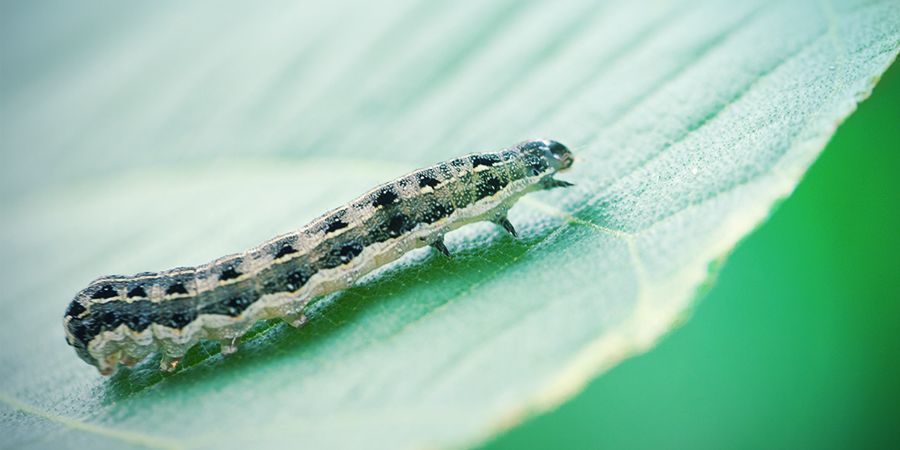
CUTWORM BIOLOGY
Cutworms are a sneaky breed of caterpillar. They look all innocent, but when no one's watching, they decapitate your cannabis plants. These cutworms usually evolve into moths from the Noctuidae family. Cutworms are classified based on their behaviour and appearance, rather than on a specific species. These little ninjas operate during the night. During the day, they hide beneath the soil surface.
They measure around 3cm in length. Mature cutworms match the circumference of a pencil and take on brown, yellow, and grey colours. When touched, they curl up into a C-shape. Their life cycle lasts for a year. During the winter, the eggs reside under the soil surface; during April-May, the eggs hatch and turn into cutworms. They rise closer to the surface, then in August, they evolve into moths, which lay eggs under the loose soil. And the cycle repeats.
DAMAGE REPORT
Cutworms cause serious damage to cannabis plants. They decapitate them by munching on the main stem. Cutworms usually feed on seedlings up until they develop around 6-8 nodes. In comparison with other pests, one has an extremely limited time frame to kill them before they destroy the crop. Once the cutworm chops off the seedling overnight, it’s over, there's no reviving the plants after that. In severe infestations, cutworms can destroy an entire plantation overnight.
PREVENTING AND COMBATTING CUTWORMS
To prevent the presence of cutworms in one's cannabis garden, a good strategy is to hedge in August and ensure that moths don’t consider your garden a thriving environment to lay their eggs. Compost, dead leaves, and various weeds (except cannabis) should be cleaned out. If cutworms are detected and sunflowers are growing near the vicinity, they should be eradicated because cutworms love sunflowers.
Cutworms hide under the soil during the day; if you see any seedlings cut off, dig a bit into the soil. If you find any cutworms, the site needs to be treated with insecticides immediately. Since cutworms feed at night, the insecticides should be applied during the evening.
You could also mulch your site as it welcomes frogs, which feast on cutworms. Using cornmeal can work as well. Flies, ants, and cutworms feed on it, but can't digest it, which leads to their death. One can use a Bacillus thuringiensis pesticide; it's very effective on cutworms.
CRICKETS
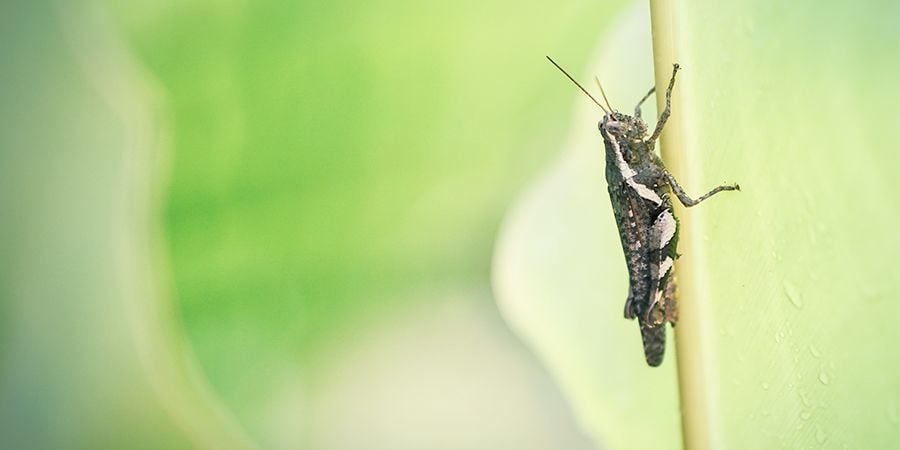
CRICKET BIOLOGY
Crickets are famous insects present in our gardens and in The Adventures of Pinocchio. Unfortunately, they pose a great danger to our beloved cannabis crop. They love munching on cannabis leaves and can’t get enough of it. There are two main types of crickets to look out for, regular field crickets and mole crickets. Regular field crickets are easier to detect than mole crickets, which live underground.
Crickets are nocturnal insects, meaning they’re mostly active at night. They’re often recognised by their loud chirping sounds at night, which can be soothing to some, but for cannabis growers, it’s the sound a crop massacre. Crickets are a part of the Gryllidae family. More than 900 species have been identified around the world. It’s not certain which crickets love cannabis the most.
DAMAGE REPORT
Cricket damage is often characterised by holes in cannabis leaves. Crickets eat plant matter, as opposed to sucking out the cell content like some bugs. Mole crickets can also munch on the roots, which leads to devastating consequences. Mole crickets dig into the soil and leave small piles of dirt that attract raccoons, birds, rats, and foxes, which can potentially harm the cannabis crop as well.
PREVENTING AND COMBATTING CRICKETS
Crickets are attracted to lights. During the night, one should minimise the light output anywhere near the plants. Also, when female plants are exposed to light during the night cycle, their quality suffers, so keeping lights at a minimum is just good practice. Crickets love the contents of trash cans. Keeping the site clean of garbage is a smart move.
One can purchase special cricket traps that capture the crickets without killing them. However, if we’re dealing with an infestation, we need to resort to insecticides. Spinosad is a safe and organic insecticide for combatting crickets.
It should be sprayed on the plants and directly on the crickets. One could also use neem oil, which is a natural and bitter oil. It should never be sprayed on buds, otherwise they will taste terrible. Plus, the substance can potentially pose a danger to us humans.
Using floating row covers can help when cannabis plants are still small, as this physically prevents the crickets from entering the plant site. One should stay away from using pyrethrin; it’s effective in killing crickets, but kills bees in the process, and killing bees is never een good idea.
MEALYBUGS
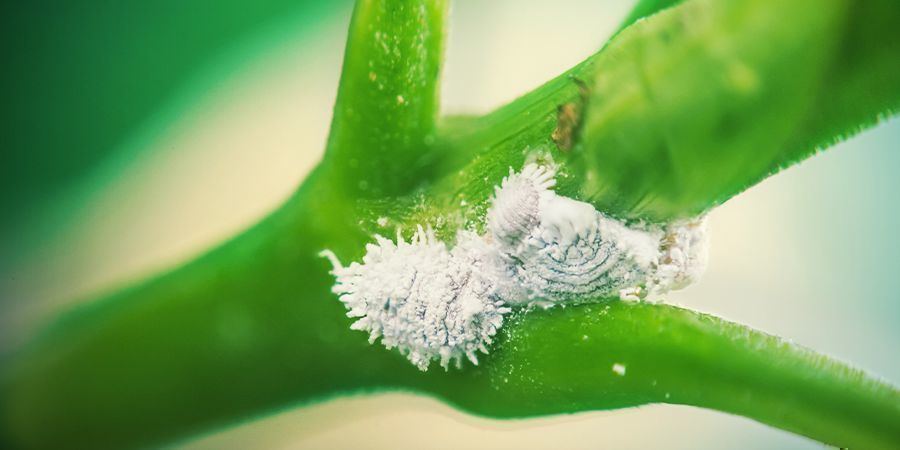
BIOLOGY OF MEALYBUGS
Mealybugs are classified as part of the Pseudococcidae family. They’re small insects, yet detectable by the human eye. They are white bugs with a slight fur. They look like Yeti insects. There are several subspecies of mealybugs, which may exhibit other colours like brown and black. They prey on many plant species. Marijuana is on their menu too.
Mealybugs pierce the plant tissue and suck out the contents. They excrete sweet honeydew, which attracts ants. Mealybugs can produce several generations in a year. Their eggs turn into larvae, which turn into mealybugs, which lay the eggs. They move around the plant quite a bit.
DAMAGE REPORT
If small brown spots are detected on leaves, it's possible that you're dealing with mealybugs. They move around and are relatively large, so they’re easily detected. Mealybugs often reside on the stems, however, they can also be found on the leaves. If one spots sticky stains on the leaves, it could be a result of the sweet honeydew that mealybugs excrete.
However, other insects such as whiteflies and aphids can also create honeydew. Mealybugs can indirectly create fungus, which prevents the photosynthesis process and darkens some parts of the plant. One should watch out for any random darkening of leaves or mould and fungi on the plants. The sweet honeydew attracts ants; if ants are spotted, mealybugs might be the cause.
PREVENTING AND COMBATTING MEALYBUGS
There are several safe methods to get rid of these pesky pests. It's better to kill mealybugs during the vegetative stage since we don't want to spray buds with various pesticides and insecticides. Diatomaceous earth won't completely remove a mealybug infestation, however, it definitely helps.
It’s an organic product produced from fossilised microalgae. When mealybugs step on the diatomaceous earth, it penetrates their shells, which leads to their death. It’s only sharp on the micro-level; it's safe for us humans.
A cotton cloth soaked with a mix of 50% water and 50% alcohol can be used to manually kill the bugs. The alcohol mixture can also be sprayed on the leaves. Neem oil and insecticidal soaps work as well. During the vegetative period, one could also blast the plants with pH-regulated water so the mealybugs fall down. It will lower their count, but won’t eradicate the problem completely. Adding ladybugs on plants also works; they consider mealybugs a delicacy.
APHIDS

APHID BIOLOGY
Aphids, also known as “plant lice”, are a part of the Aphidoidea superfamily. They are considered one of the most destructive insects - the arch-enemies of cannabis plants. They can completely annihilate our beloved ganja. These small insects, measuring around 1-10mm in length, tap into plant cells and suck them dry. Aphids can also spread deadly plant viruses, destroying crops with ease.
Their colour is usually green, but it can also be brown, white, and black. Just like mealybugs, aphids produce a honeydew substance, which ants consume. Quite interestingly, ants protect the eggs of aphids during the winter and place them on plants when it’s warm in order to get that honeydew. There are more than 4000 aphid species in the world.
DAMAGE REPORT
Aphids can be detected on cannabis plants under the leaves where they hide from sunlight. The leaves will have brown spots in locations where aphids sucked out plant matter. They honeydew they excrete shines under the light; it can also cause mould.
As mentioned, aphids attract ants. Also, the leaves can become yellow and start wilting. Aphids can cause various diseases in cannabis plants. As such, random diseases shouldn't eliminate the possibility of an aphid infestation.
PREVENTING AND COMBATTING APHIDS
Before one plants cannabis in one’s garden, consider introducing some predatory and cannabis-friendly insects like ladybugs, aphid midge larvae, parasitic wasps, and lacewings, which feed on aphids. However, this is unlikely to solve a full-on infestation.
Spinosad, insecticidal soaps, Essentria IC3, and neem oil will do the trick. Spinosad is a great and organic way to get rid of aphids. One could also add Spinosad into the plant's water supply to kill aphids lurking in the soil. Some growers use natural essential oils like rosemary, lemon, and cinnamon oils, which are mixed with water and sprayed on the leaves using a mister.
ANTS
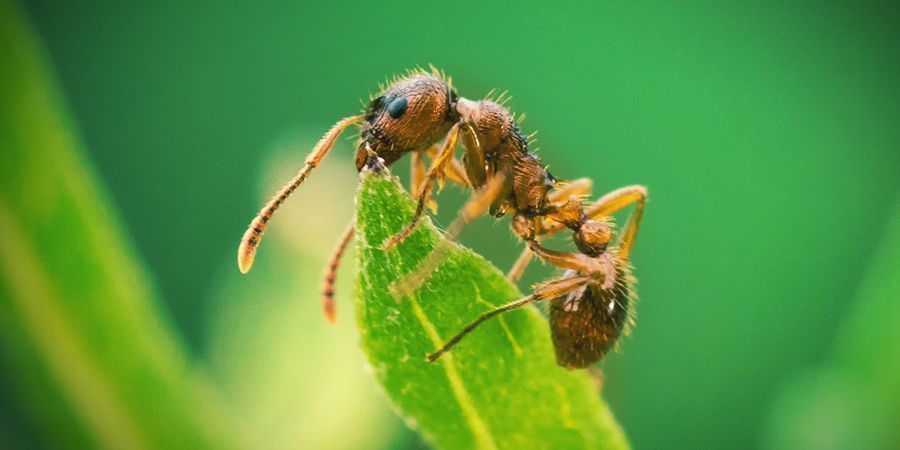
ANT BIOLOGY
We consider ants to be extremely smart insects. We're investigating their behaviour with great scrutiny. There are more than 12,000 ant species discovered. They’re 6 legged insects that can be beneficial and simultaneously destructive to cannabis plants. A couple of ants in the plantation can help create tunnels in the soil, allowing oxygen to pass through, which feeds the roots.
Ants consume dead insects, which in turn, converts into valuable nutrients for cannabis plants. On the other hand, ants also farm aphids, which are highly undesirable insects in cannabis plantations because they can destroy plants. Even though ants themselves won’t destroy plants, they will encourage other insects to do so.
DAMAGE REPORT
Ants and aphids have a symbiotic relationship. Ants love the honeydew that aphids produce. Ants farm aphids by storing their eggs underground during winter. These eggs are placed on various plants during spring, which turn into aphids, which produce the honeydew for ants. Therefore, the damage done by aphids may have resulted from an ant infestation.
One should look for brown spots on leaves, randomly dehydrated cannabis plants, mould, fungi, and honeydew. Also, ants are quite easy to spot because they are very active and move a lot.
PREVENTING AND COMBATTING ANTS
Ants hate cinnamon, cayenne pepper, and coffee. One could mix ground cinnamon with pH-regulated water and spray it on the ground. It will smell great, kill the ants, and prevent any other ants from entering the area. Diatomaceous earth will do wonders. It’s important to buy food-grade diatomaceous earth, which is a non-toxic way of killing the ants. These tiny particles penetrate the ant's body, which results in their death.
Some growers introduce ants into the plantation to help with soil conditions, however, this method should be left to master botanists. Instead, earthworms could be introduced, which decompose nutrients and make them easier to absorb by plants. Earthworms also create tunnels, allowing plants to receive oxygen.












 United States
United States








